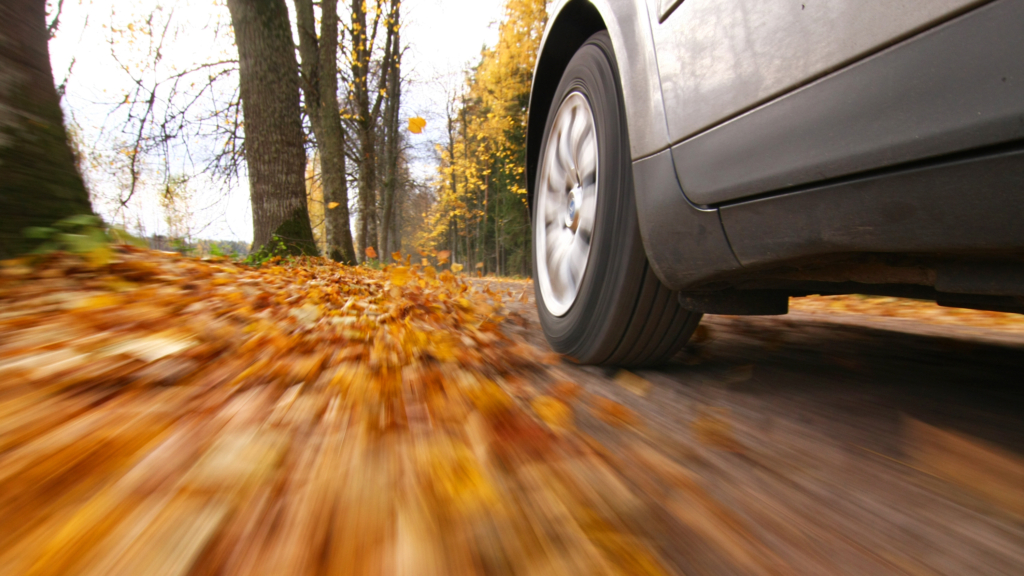Driving in fall and winter presents unique challenges that all drivers need to be aware of. From sun glare to slippery leaves and icy roads, these conditions require extra caution. Preparing for these seasonal changes can help drivers avoid accidents and stay safe on the road. In this article, we will explore essential driving tips for navigating both autumn and winter road hazards.

What You Will Learn:
- How to adjust your driving habits for autumn and winter conditions.
- The impact of sun glare during fall and winter and tips on how to handle it.
- The dangers of wet leaves on roads during the fall and how to safely navigate them.
- Essential winter driving tips to help you stay safe on icy and snowy roads.
- Why sunglasses are a must for driving during fall and winter months.
How Fall & Winter Affect Driving Conditions
As the seasons change, so do our driving habits. It’s that time of year when cooler weather arrives, and the trees start shedding their leaves. You might be packing away your summer gear, but one thing you should keep within reach is your sunglasses. Autumn and winter often bring a low-sitting sun, especially during sunrise and sunset, which can cause blinding glare while driving.
Pro Tip: Keep your windshield clean inside and out. Sun glare becomes worse when your windshield is dirty, as dust and streaks can intensify the blinding effect. Regularly clean your windshield to improve visibility and reduce glare during sunrise and sunset.
Ready to master safe driving in any season? Enroll in a comprehensive driving course at Driven2Drive and learn essential skills to stay safe on the road year-round!
How to Handle Sun Glare in Fall and Winter
Just the other day, I was driving on a beautiful fall evening. The sun had just started to set, and suddenly, I was blinded by the intense glare of the beautiful sun. In these situations, it’s essential to keep your sunglasses handy. If the sun blinds you while driving, shift your focus to the pavement markings to help maintain control. Most importantly, avoid sudden movements. Slow down gradually and steer steadily until your visibility improves.
Navigating Wet Leaves, Rain & Frost
Sun glare isn’t the only thing drivers must be cautious of during the fall season. Autumn also brings more frequent and heavier rainfall. While rain itself poses a challenge, wet leaves on the road can be just as hazardous. When driving in the rain, leaves can make the roads extremely slippery, reducing traction and increasing the chances of accidents.
To stay safe, reduce your speed and increase your braking distance. Start braking earlier than usual to compensate for the slick road surface. By planning ahead, you’ll ensure you have enough time to stop safely, even in challenging driving conditions.
Icy Roads and How to Stay Safe
Winter driving brings its own set of challenges, including icy roads and reduced visibility due to snow or fog. In these conditions, it’s important to keep your vehicle in top shape. Ensure your tires are suitable for icy or snowy roads, and check that your windshield wipers are functioning properly. Reduced traction on icy roads can lead to skidding, so drive at lower speeds and increase the distance between your vehicle and others.
Visibility is another key concern in winter. Snow can reduce your ability to see the road clearly, so it’s crucial to keep your headlights clean and on. Additionally, using fog lights when necessary can improve your ability to see and be seen in low-visibility situations.
Pro Tip: In winter, always check your tire pressure regularly. Cold weather can cause tire pressure to drop, reducing traction on snowy or icy roads. Properly inflated tires will help you maintain better control of your vehicle, especially in slippery conditions.
Don’t take chances with seasonal driving hazards. Get personalized driving coaching at Driven2Drive and feel confident navigating autumn and winter roads.
Staying Safe Throughout the Seasons
By preparing for seasonal challenges, you can ensure a safer driving experience during autumn and winter. Keep your sunglasses handy to combat sun glare, slow down on wet roads, and practice cautious driving when conditions are icy. Driving safety is all about awareness, preparation, and caution.
Why Sunglasses Aren’t Just for Summer
While most people associate sunglasses with summer, they are just as important for autumn and winter driving. The sun sits lower on the horizon during these seasons, creating intense glare during sunrise and sunset. Keeping sunglasses in your car ensures that you’re prepared to protect your eyes and maintain visibility when driving in these conditions.
Key Takeaways:
- Always keep sunglasses handy in autumn and winter to protect against low sun glare.
- Slow down and increase your braking distance when driving on wet, leaf-covered roads.
- Be mindful of icy conditions in winter by driving at reduced speeds and maintaining extra distance between vehicles.
- Regular vehicle maintenance, such as checking tires and windshield wipers, is essential for winter driving safety.
- Awareness and preparation are crucial to staying safe while driving in changing seasonal conditions.
Focus on Driving Safety Year-Round
Remember, driving safety should always be a priority, especially in the changing conditions of fall and winter. By being mindful of low sun, wet leaves, and unpredictable weather, you can navigate these seasons with confidence. Safe driving practices, such as reducing speed and increasing braking distances, are essential for staying safe. Till next time, drive safely!
If your car begins to skid, don’t panic. Gently steer in the direction of the skid, avoid sudden braking, and reduce your speed.
Keep sunglasses handy, clean your windshield regularly, and lower your sun visor to reduce glare during sunrise and sunset.
Slow down, increase your braking distance, and watch for frost on the road, especially in the morning or after sunset.
Related resources
- Defensive Driving Techniques: Simple Road Safety
- Night Driving Safety: Everything You Need to Know
- The Top 10 Safe Driving Habits Every Teenager Should Adopt
- Driving in Cold Weather: Best Tips for Safety
- Driving Safety Tips: Stay Safe on Halloween in PA

Ronit Tehrani is the Founder and Co-Owner of Driven2Drive, a premier driving and license testing center in Philadelphia. Since 2013, she has been dedicated to providing safe driving education and skills for lifelong success. Under her leadership, Driven2Drive became Pennsylvania’s first privately owned PennDOT-certified testing center, now with six locations.
